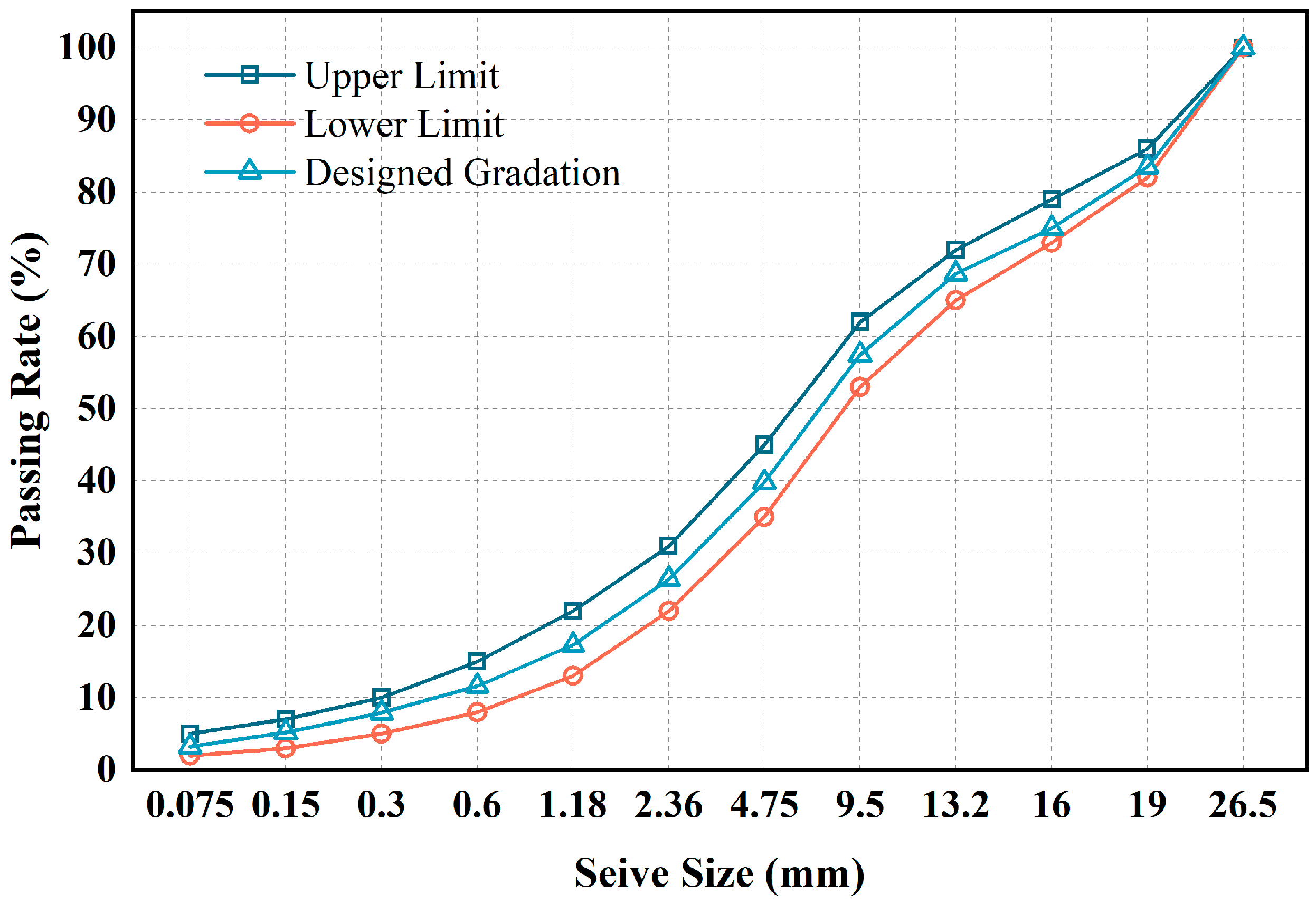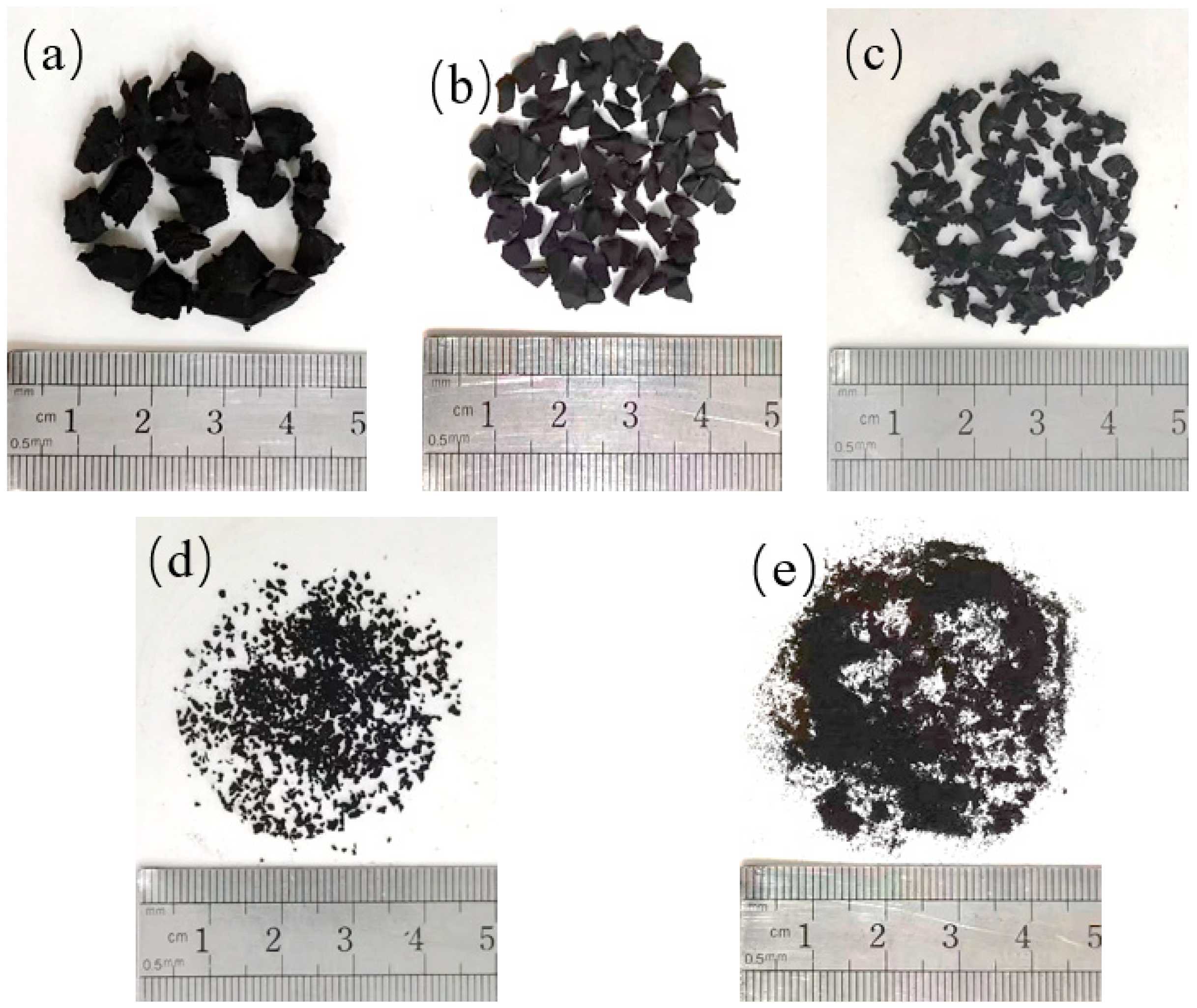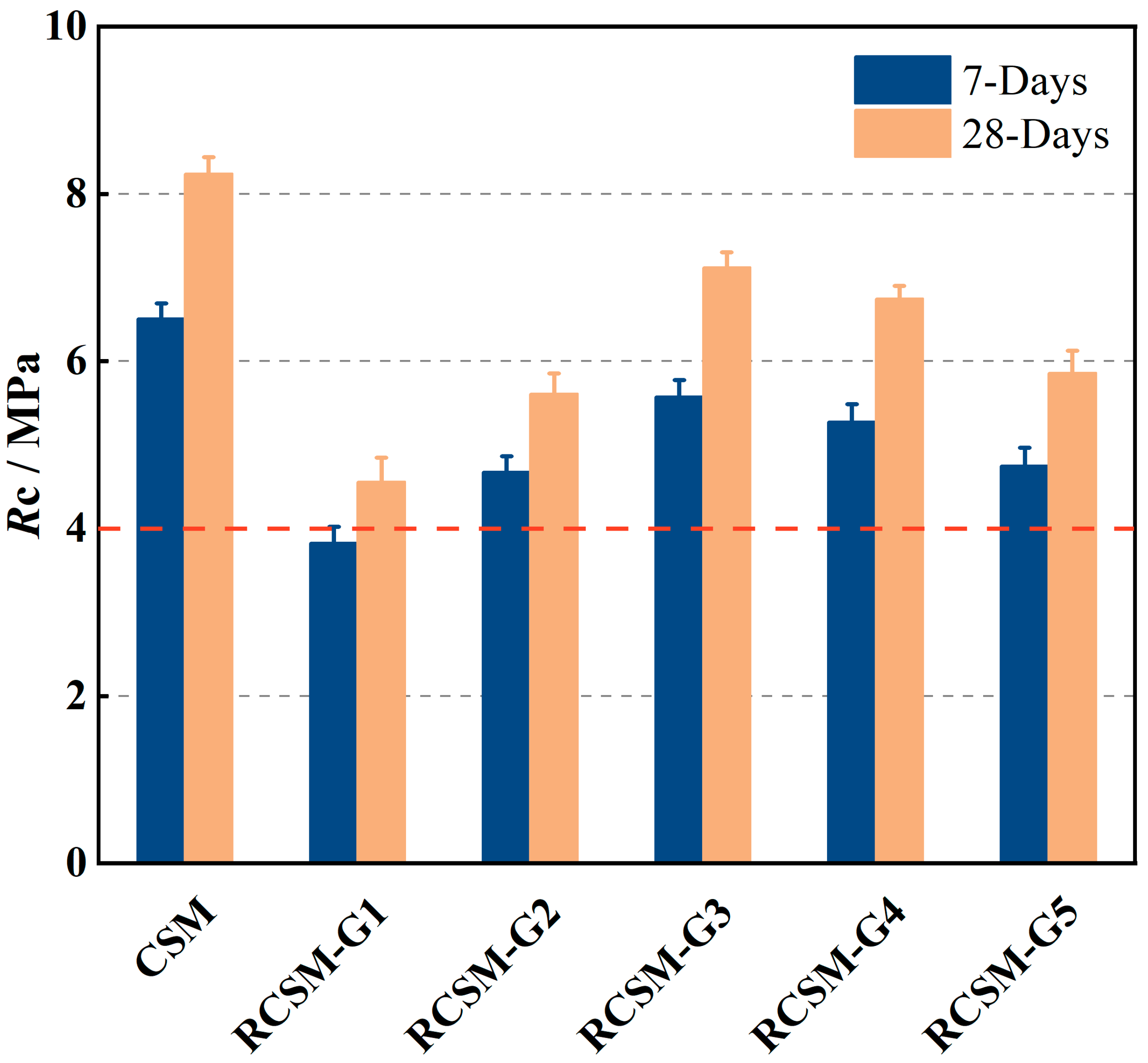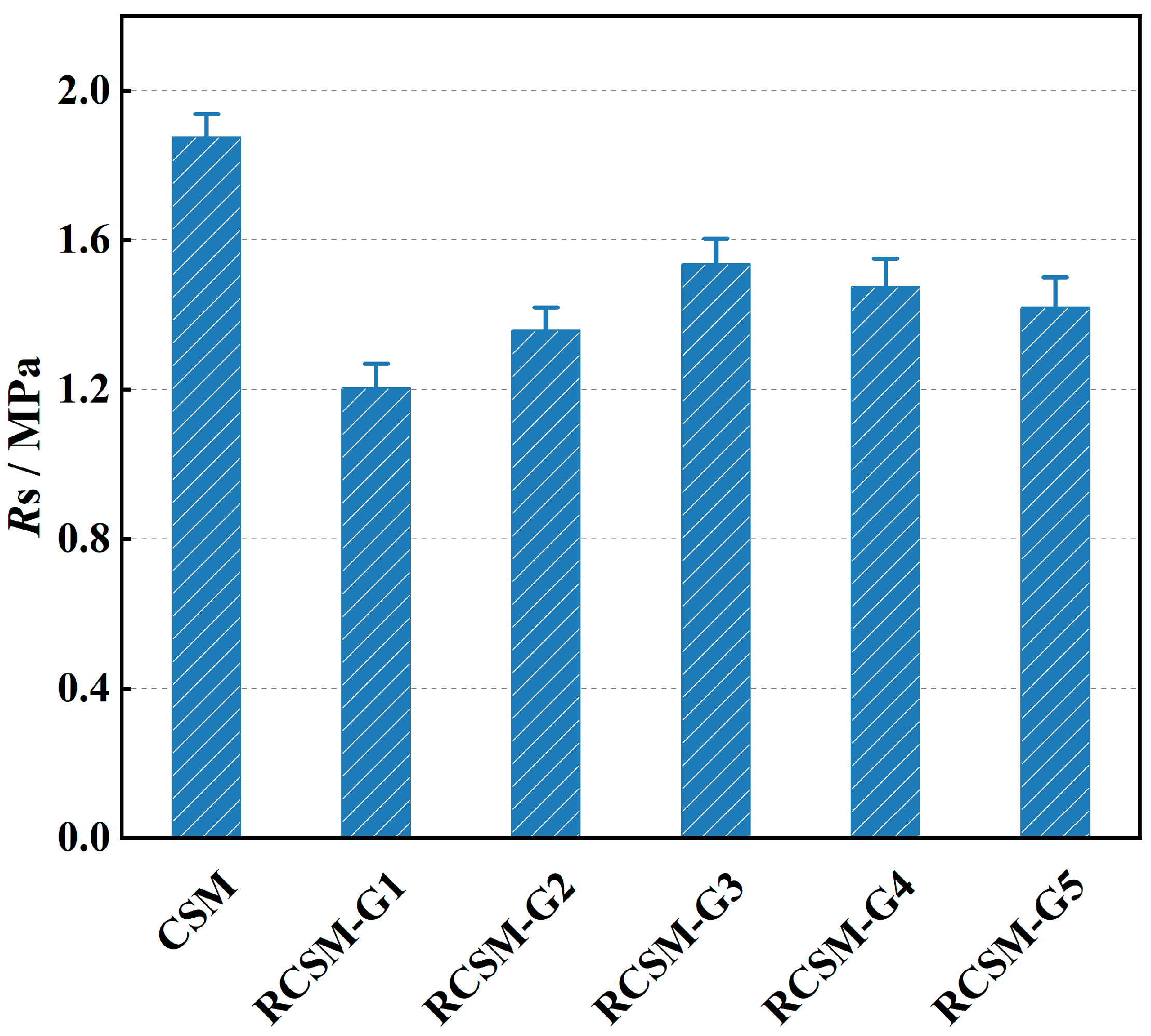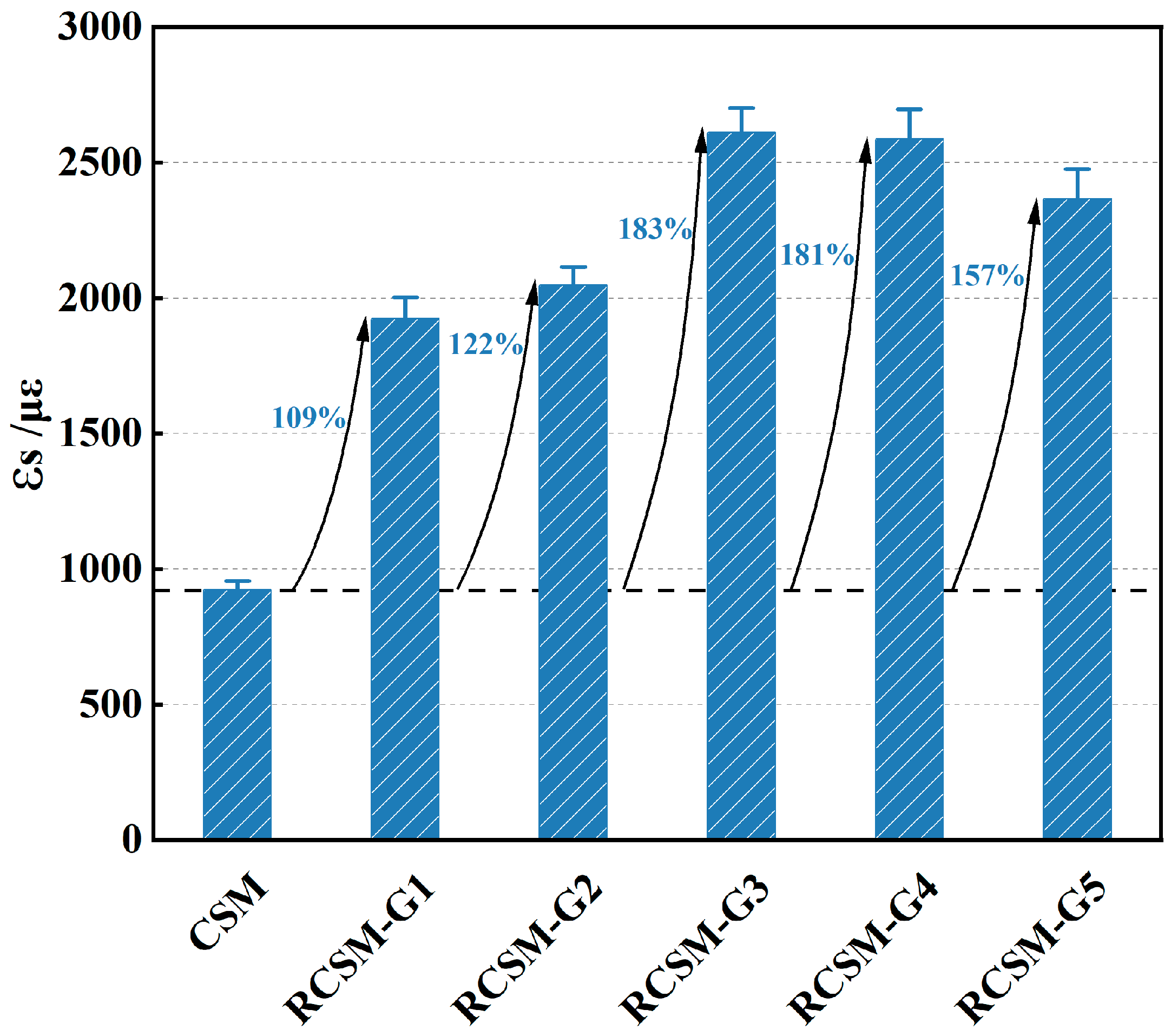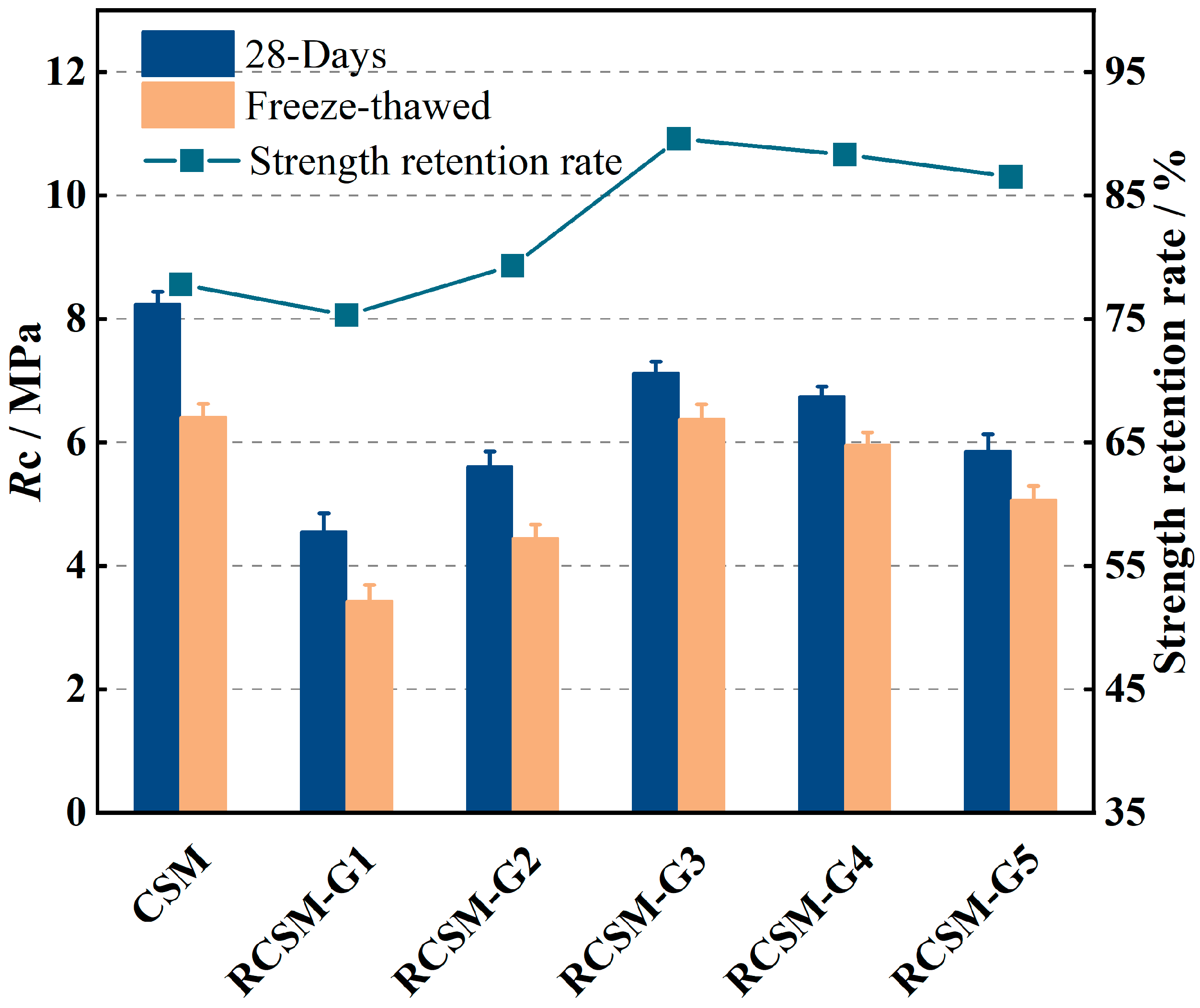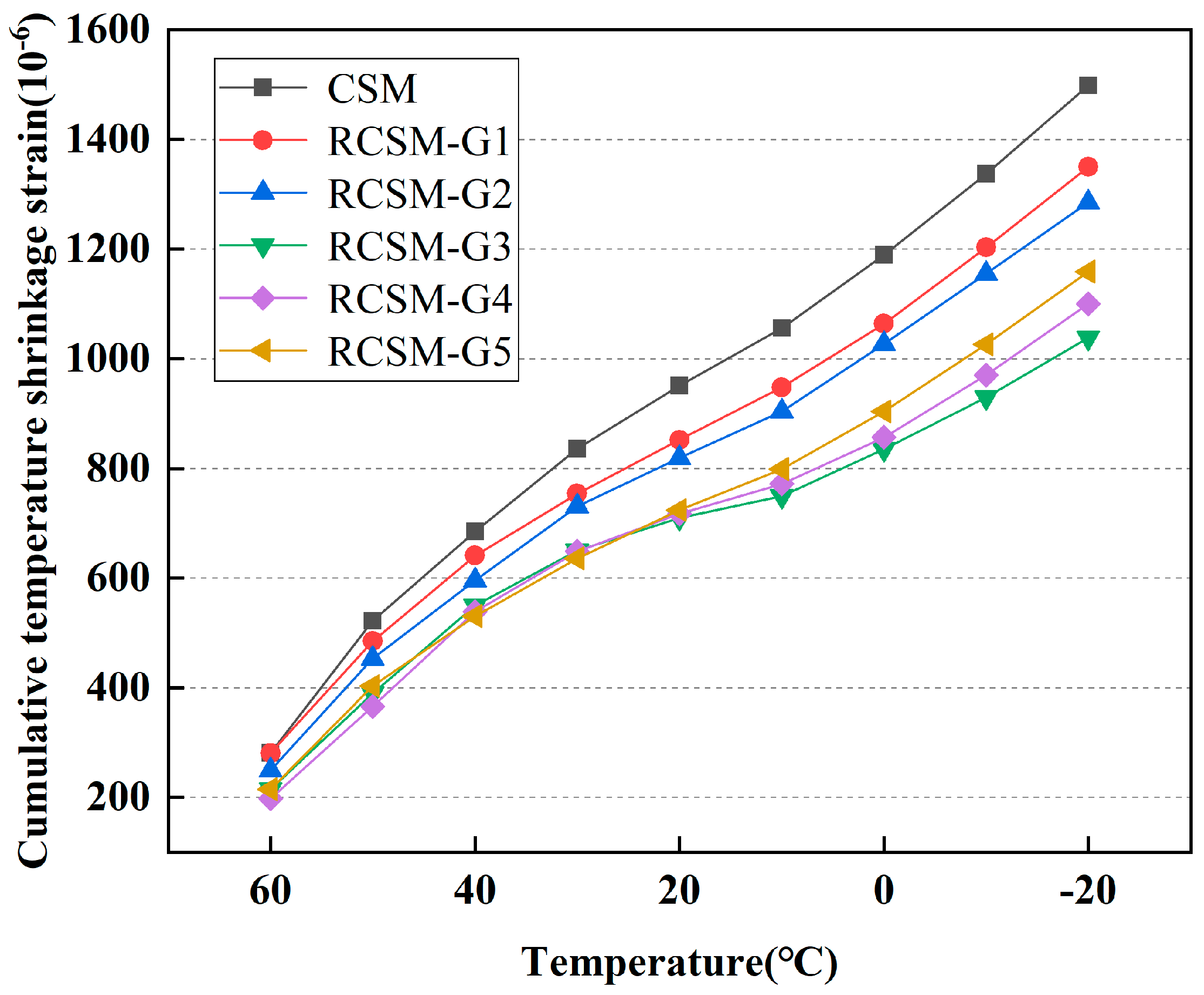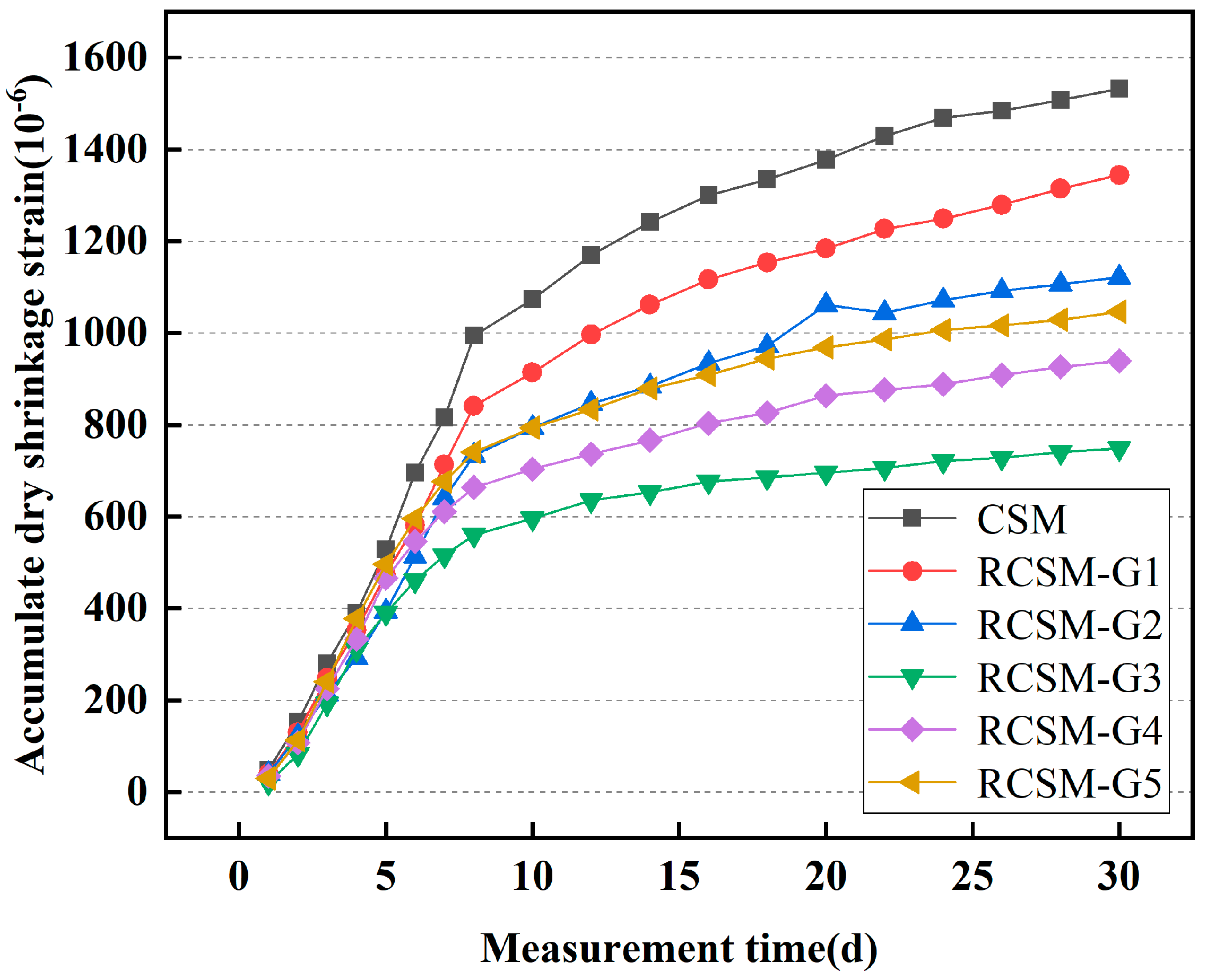1. Introduction
Accumulating scrap rubber tires is a significant global environmental problem [
1,
2,
3]. Around 1 billion waste tires are generated annually worldwide, with estimates suggesting this could rise to 1.2 billion by 2030 [
4,
5,
6]. Due to rubber’s non-biodegradable nature, improper disposal can negatively impact ecological and environmental health [
7]. In recent decades, recycled rubber particles have been used as modifiers in asphalt binders and as substitutes for natural aggregates in concrete production [
8,
9,
10]. Studies show that wet-processed crumb rubber modified asphalt mixtures offer improved cracking, rutting, and fatigue resistance [
11,
12,
13]. However, it should be noted that the addition of crumb rubber substantially increases the viscosity of asphalt binders [
14], which complicates the mixing and placement processes. Therefore, there exists a practical upper limit on the crumb rubber content, beyond which the workability and technological performance of the binder deteriorate. Additionally, incorporating rubber into concrete has been shown to enhance toughness, durability, and functional properties, including improved impact resistance, freeze–thaw performance, and ductility [
15,
16,
17,
18,
19,
20,
21,
22,
23,
24,
25]. Nonetheless, other challenges may occur, including reduced compressive strength, delayed setting, and weakened interfacial bonding between rubber particles and the cementitious matrix, all of which merit further investigation.
Reusing discarded rubber addresses disposal issues and conserves natural aggregates, benefiting the environment and the economy [
26]. Cement-Stabilized Macadam (CSM) is the main material used for China’s semi-rigid base of high-grade highway pavements. Because CSM is brittle and highly sensitive to temperature and moisture variations, it cannot effectively dissipate thermal and drying shrinkage stresses, frequently leading to shrinkage cracks [
27,
28]. Additionally, its limited toughness leads to deformation incompatibility with the overlying asphalt layers. This increases the concentration of tensile stresses at the bottom of the semi-rigid subgrade, ultimately causing fatigue cracking under repeated loads. Therefore, developing high-toughness semi-rigid base materials is crucial for improving crack resistance and ensuring long-lasting asphalt pavements.
Methods for improving the toughness of cement-based materials mainly include fiber reinforcement and rubber modification. Fiber-reinforced concrete (FRC) has recently seen widespread use, such as polypropylene fiber concrete, basalt fiber concrete, alkali-resistant glass fiber concrete, and steel fiber concrete [
29,
30]. However, FRC is still not fully effective in controlling crack propagation. While FRC offers greater toughness than traditional concrete, it still exhibits strain-softening behavior under direct tensile loading, often leading to wider and more damaging cracks [
31,
32]. Engineered cementitious composites (ECC) [
33] are concrete materials with lower fiber content, demonstrating strain-hardening behavior, such as PE-ECC [
34] and PVA-ECC [
35]. Similarly, ultra-high-toughness cementitious composites (UHTCC) [
36] further enhance crack control and exhibit superior strain-hardening performance compared to FRC. It was found that [
37] about 0.3% volume fraction of PVA fibers can increase concrete’s compressive and splitting tensile strength by 15.75% and 36.09%, respectively, compared to plain concrete.
Scrap rubber tires, classified as environmental pollutants, exhibit good elasticity and a low stiffness modulus. Incorporating rubber particles into cement-based materials significantly enhances toughness, offering performance and environmental benefits. This indicates that rubber particles significantly reduce the stiffness of concrete. Additionally, Goulias [
38] found that the brittle damage of rubber concrete specimens improved as the rubber content increased. Hou [
39] et al. reported that smaller and more uniformly graded rubber particles can more effectively control crack width. The same principle applies to Rubber-Cement-Stabilized Macadam (RCSM). Ahmed [
40] reported that the flexural strength and stiffness of RCSM decreased after adding rubber. Under splitting and bending loads, the ultimate strains of RCSM are 1.9 and 3.79 times greater than those of conventional CSM, respectively. Despite the reduction in strength, the significant increase in toughness effectively improves crack resistance in a semi-rigid base.
However, weak adhesion between rubber particles and the cement matrix creates numerous defects in the interfacial transition zone (ITZ), likely accelerating the failure of the hardened mixture. The hydrophobic nature of rubber particles is the main cause of their weak bond with hardened cement paste. Surface modification has been shown to enhance the bond between rubber and cement. Research shows that washing with water can remove impurities from the rubber surface [
36]. Pre-coating rubber surfaces with cementitious materials forms hydrophilic cement shells, improving the bond between rubber aggregates and the cement matrix [
41].
The bond strength is strongly influenced by particle size, with smaller rubber particles generally forming stronger interfaces. Yu et al. [
42] demonstrated that the strength of concrete mixed with 2–4 mm crumb rubber decreased less than that of concrete mixed with 60–80 mesh (0.18–0.28 mm) powdered rubber. Piti [
43] reported that the shrinkage rate of rubber concrete using large-sized rubber particles is typically higher than that of concrete using small-sized rubber particles. Yu et al. [
44] stated that 1–3 mm rubber particles were more effective at inhibiting cracking than those with sizes of 2–4 mm and less than 2 mm. Although particle size strongly influences the behavior of rubberized cement-based materials, its effect has not been systematically investigated. Most studies have focused on rubber concrete, with limited research in CSM.
This research aims to explore the correlation between rubber particle size and the road performance of RCSM. The goal is to develop RCSM with enhanced toughness and superior crack resistance through optimal rubber gradation. Different rubber particle size combinations were designed and incorporated into RCSM. Unconfined compressive strength, four-point bending, freeze–thaw, and shrinkage tests were conducted on RCSM. The impact of rubber particle size distribution on the strength and toughness of RCSM was evaluated through laboratory experiments. Meanwhile, the optimal rubber particle size range for RCSM was proposed. This paper proposes a method that significantly enhances the deformability and durability of CSM while maintaining strength. This method is significant for efficiently using waste rubber and for environmental protection.
4. Results and Discussion
4.1. Unconfined Compressive Strength
The compressive strength results of RCSM at various curing ages are illustrated in
Figure 6. Compared to CSM, the incorporation of rubber particles significantly reduced the compressive strength, attributed to their poor strength and hydrophobic nature. With the original tougher aggregates replaced by rubber particles, the strength of RCSM would definitely decrease. Furthermore, the hydrophobic rubber particles failed to form strong interfacial bonds with the cement paste, weakening the overall strength.
For RCSM-G1, the compressive strength losses at 7 days and 28 days were 41% and 45% compared to CSM, respectively, significantly higher than other RCSM. Moreover, the 7-day compressive strength of RCSM-G1 was below 4 MPa, failing to meet specification requirements. One possible reason for the significant strength deterioration is the absence of coarse aggregates in RCSM-G1. Coarse aggregates, typically larger than 4.75 mm, form a strong skeletal structure when embedded and locked together within the mixture. The strength of RCSM relies heavily on this skeletal structure, but replacing coarse aggregates with rubber particles substantially weakens it. Additionally, another possible reason is that coarse rubber particles negatively impact the compaction performance of the mixture. During compaction, rubber absorbs energy and undergoes resilient deformation, resulting in poor compaction. As a result, the strength of RSCM-G1 was significantly compromised, suggesting that RCSM should not be manufactured with rubber particles larger than 4.75 mm.
From RCSM-G1 to RCSM-G5, the compressive strength exhibited a hump-shaped trend, with the inflection point occurring at RCSM-G3. The 7-day and 28-day compressive strength of RCSM-G3 remained above 85% of regular CSM, indicating that the use of 1.18–4.75 mm rubber particles provided excellent strength retention. Furthermore, the strength retention of 1.18–2.36 mm rubber particles was superior to that of 2.36–4.75 mm particles, as demonstrated by the comparison between RCSM-G2 and RCSM-G3.
According to RCSM-G4 and RCSM-G5, the strength of the mixture began to decrease when rubber particles smaller than 1.18 mm were added. The primary reason may be the reduction in the content of silty aggregates in the mixture. When water infiltrates, silty aggregates tend to bond with surrounding aggregates due to capillary pressure. Consequently, capillary pressure was reduced when the silty aggregates were partially replaced by hydrophobic rubber particles, which ultimately decreased strength.
The interfacial behavior between rubber particles and CSM aggregates can be further explained from a hydrophilic–hydrophobic adhesion perspective. Rubber is hydrophobic and non-polar, whereas the cementitious matrix is hydrophilic and dominated by polar hydration products. This mismatch weakens chemical bonding at the rubber–mortar interface, resulting in lower strength but allowing greater deformation and crack-dissipation capacity.
4.2. Flexural Tensile Test
4.2.1. Flexural Tensile Strength
As shown in
Figure 7, incorporating rubber particles reduced the flexural tensile strength of CSM by 18–36%, mainly due to the weak interfacial bonding between the hydrophobic rubber and the cement matrix. The reduction was most pronounced in RCSM-G1, whose strength was only about 64% of that of CSM. This can be attributed to the loss of the coarse aggregate skeleton structure and the formation of voids within the interfacial transition zone caused by large rubber particles (>4.75 mm).
Among the tested mixtures, RCSM-G3 exhibited the highest flexural strength retention, reaching approximately 82% of CSM. Its strength was 9% higher than that of RCSM-G2, indicating that rubber particles in the range of 1.18–4.75 mm provide an optimal balance between strength and flexibility. When finer particles (<1.18 mm) were used (RCSM-G4 and RCSM-G5), flexural strength decreased further, as excessive fine rubber weakened the aggregate bonding and increased internal porosity.
4.2.2. Flexural Ultimate Failure Strain
As illustrated in
Figure 8, incorporating rubber particles enhanced the deformation capacity and toughness of RCSM. The flexural ultimate failure strain exhibited a hump-shaped pattern across RCSM-G1 to RCSM-G5. RCSM-G1 demonstrated the smallest increase in ultimate strain, approximately 2.1 times that of CSM. Rubber particles larger than 4.75 mm could not embed into the aggregate skeleton during compaction, so they continuously absorbed stress and exhibited resilient deformation. This impeded the adequate compaction of the mixture. Therefore, replacing coarse aggregate with large rubber particles is not a viable approach for improving the toughness of RCSM.
The ultimate failure strain of RCSM-G3 was nearly 2.8 times that of regular CSM, indicating the highest toughness improvement. The gradation of RCSM-G3 consisted of 1.18–4.75 mm rubber particles, effectively filling the voids in the aggregate skeleton under vibratory loading. After compaction, the mixture achieved good contact, forming numerous interfacial contact points between rubber particles and aggregates. Consequently, stress within the mixture was efficiently transferred to and absorbed by the rubber particles.
According to test results from RCSM-G4 and RCSM-G5, the ultimate strain of RCSM decreased when rubber particles smaller than 1.18 mm were incorporated. Based on this result, the lower limit of rubber particle size for toughness improvement was determined to be 1.18 mm.
4.3. Flexural Tensile Resilient Modulus
Figure 9 indicates that RCSM exhibits greater flexibility compared to CSM. Given that the stiffness modulus of tire rubber ranges from 0.47 to 2.7 MPa [
48], the modulus of the multi-phase material varies depending on the rubber composition and volume fraction. Therefore, the modulus of RCSM can be adjusted by controlling the rubber gradation. The moduli of RCSM-G1 and RCSM-G2 were approximately 64% and 57% of that of CSM, respectively, with a smaller reduction than RCSM-G3. The results suggest that the range of RCSM modulus adjustment with a single rubber particle size is considerably narrower than that of mixed rubber gradations. The modulus of CSM can be reduced by altering the gradation of rubber particles. Furthermore, rubber particles between 1.18 and 2.36 mm were found to be the most effective in relieving the stiffness of CSM among all the tested rubber particles.
4.4. Fatigue Properties
Table 8 shows that for the same mixture, the
n values derived from the fatigue equation based on stress ratio and stress level are quite similar, and the
n values across different mixtures show slight variation. However, the
k values differ significantly among the mixtures. The
k value of the CSM fatigue curve is lower than that of the other RCSM fatigue curves, indicating that, under the same nominal stress ratio, RCSM has a longer fatigue life than CSM. Data from
Table 9 reveal that the
k value of the CSM fatigue curve associated with stress levels is relatively high, implying that CSM can withstand repeated loading as effectively as RCSM under the same stress conditions.
Additionally, whether based on stress ratio or stress level, the k value of the fatigue curve for the mixture with combined particle size rubber gradation is significantly higher than that of the single particle size gradation. Specifically, the RCSM-G3 mixture exhibits the highest k value among all tested mixtures, demonstrating that optimizing rubber particle gradation not only enhances the strength and toughness of CSM but also significantly improves its fatigue performance.
4.5. Freeze–Thaw Test
The freeze–thaw test results are provided in
Figure 10. After five freeze–thaw cycles, the unconfined compressive strength of the mixtures decreased significantly. Meanwhile, the strength retention rate (the ratio of strength after to before freeze–thaw) indicates that, except for RCSM-G1, the strength retention of RCSM is superior to that of CSM. RCSM-G1 experienced the most severe frost swelling due to the large voids within the mixture.
The strength of RCSM-G3 decreased from 7.12 MPa before freeze–thaw to 6.38 MPa afterward, resulting in a strength retention of approximately 89.6%. This demonstrates that rubber particles with sizes between 1.18 and 4.75 mm effectively enhanced the freeze–thaw durability of RCSM. Water freezing caused volume expansion, generating expansion stress within the mixture during the freeze–thaw process. Nonetheless, elastic rubber particles could prevent this stress from acting directly on the CSM through stress absorption. Additionally, in RCSM-G4 and RCSM-G5, incorporating rubber particles smaller than 1.18 mm deteriorated the frost resistance durability. The wide range of rubber particle sizes caused excessive seepage pressure within the mixture. Water in the capillaries contained soluble salts, which created a concentration gradient between pores of different sizes. As the free water temperature in the pores drops to the freezing point, unfrozen water is continuously adsorbed and accumulates due to seepage pressure. Consequently, significant seepage pressure was generated within the ITZ.
4.6. Temperature Shrinkage
As shown in
Figure 11, the cumulative temperature shrinkage strain increased as the temperature rose. Owing to their excellent deformability, rubber particles can effectively absorb the temperature-induced shrinkage stress in CSM. The cumulative strain of RCSM was notably lower than that of CSM, indicating that adding rubber particles reduced the temperature-induced shrinkage deformation in semi-rigid subgrade materials. Consequently, the anti-cracking performance of the semi-rigid subgrade was markedly improved.
CSM exhibited the highest cumulative strain of 1217 με among all the mixtures tested. The cumulative strain of RCSM decreased with the addition of rubber particles. Rubber particles absorb the shrinkage stresses caused by temperature decreases, thus reducing the temperature shrinkage strain of mixtures. Specifically, the cumulative strain of RCSM-G1 and RCSM-G2 decreased by 20.3% and 15.4%, respectively, compared to CSM. RCSM-G1 and RCSM-G2 contain larger rubber particles, which are less well-dispersed than fine particles in the mixtures. Therefore, the mitigation effect of single-sized rubber particles on temperature shrinkage in the mixture is less effective than that of rubber particles with combined gradations. Furthermore, no additional improvement in temperature-induced shrinkage strain was observed in RCSM when rubber particles smaller than 1.18 mm were added. These findings suggest that the optimal rubber particle size for enhancing the temperature shrinkage performance of RCSM ranges from 1.18 mm to 2.36 mm.
4.7. Dry Shrinkage
Figure 12 illustrates the cumulative dry shrinkage strain variation in RCSM over time. Generally, the drying shrinkage of base course materials primarily occurs during the early stages of paving. Therefore, the monitoring interval for this test was set between 1 and 30 days. The rate of increase in dry shrinkage strain for specimens was relatively high during the early stages, irrespective of whether rubber particles were added. After 7 days, the rate of increase began to slow, attributed to the significant loss of surface moisture during the initial stage of the test. Subsequently, the internal moisture starts to act due to adsorbed water and intermolecular forces. As a result, the water loss rate slows, and the cumulative dry shrinkage strain growth rate decreases.
After 30 days of continuous drying, the cumulative dry shrinkage strain of CSM reached 1532.3 με. By contrast, the cumulative dry shrinkage strains of RCSM-G1 to RCSM-G5 were 1344.5 με, 1121.7 με, 748.6 με, 938.9 με, and 1046.6 με, respectively. The cumulative dry shrinkage strain of RCSM-G3 was reduced by 51% compared to CSM, indicating that the rubber particles effectively reduced the dry shrinkage strain in CSM.
When the rubber gradation includes two or more particle sizes, the cumulative dry shrinkage strain of RCSM is lower than that of mixtures with single-sized rubber particles. This is primarily due to the excessive replacement of single particle sizes in RCSM-G1 and RCSM-G2, which significantly weakened the skeletal structure of CSM. However, including overly fine rubber particles increases the number of micro-pores in the mixture, resulting in more significant drying shrinkage stresses. Consequently, the cumulative dry shrinkage strain for RCSM-G4 and RCSM-G5 increased compared to RCSM-G3.
Table 10 summarizes the key results from
Section 4. Overall, incorporating rubber particles reduced compressive and flexural strengths due to weaker interfacial bonding but significantly enhanced toughness, flexibility, and durability. The RCSM-G3 mixture, containing rubber particles sized between 1.18 and 4.75 mm, achieved the best balance among strength, fatigue resistance, and shrinkage performance. The correlations indicate that moderate stiffness reduction improves crack resistance and freeze–thaw durability through enhanced energy dissipation and stress absorption.
5. Conclusions
This study proposed an optimization method for rubber gradation. It addressed the inconsistency in gradation caused by unequal replacement particle sizes between rubber and aggregate. By optimizing rubber use in cement-based materials, the method enhances rubber utilization while improving the toughness and durability of cementitious materials. The main conclusions can be summarized as follows:
(1) Due to the weak bonding of the incorporated rubber particles, the flexural tensile strength and unconfined compressive strength of RCSM significantly decreased. Rubber particles larger than 4.75 mm or finer than 1.18 mm are not recommended to replace aggregates.
(2) The deformability and toughness of RCSM improved significantly with the introduction of flexible rubber particles. The ultimate failure strain of RCSM-G3 increased by 1.83 times compared to CSM. Additionally, rubber gradation optimization can reduce the flexural tensile modulus of RCSM to less than half that of CSM.
(3) Except for RCSM-G1, optimizing the rubber gradation significantly enhanced frost resistance durability and decreased the fatigue stress sensitivity of RCSM. The optimal rubber particle size for improving the road performance of RCSM ranged from 1.18 to 2.36 mm.
(4) The incorporation of rubber particles significantly reduced both the drying shrinkage strain and temperature shrinkage strain of RCSM. Moreover, RCSM with two or more rubber particle sizes exhibited a lower cumulative shrinkage strain than RCSM with single-sized particles.
(5) The incorporation of waste rubber particles into CSM significantly improves its long-term durability, offering a sustainable solution for reducing natural aggregate consumption in road construction.
This study establishes a quantitative optimization approach for rubber gradation in RCSM, revealing that rubber particles between 1.18 and 2.36 mm offer the best balance of strength and flexibility. The fatigue life of RCSM-G3 increased by approximately 1.8 times compared with conventional CSM, while frost resistance and shrinkage performance were significantly improved. These findings provide a practical reference for the design of crack-resistant semi-rigid base materials in highway pavements, contributing to the recycling of waste rubber and reduction in natural aggregate consumption. Although this study systematically analyzed the mechanical and durability properties of RCSM with optimized rubber gradation, certain limitations remain. The experimental program was conducted under laboratory conditions, and field verification of the long-term performance of RCSM in actual pavement structures has not yet been performed.
